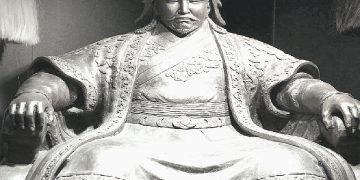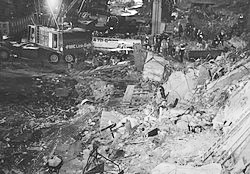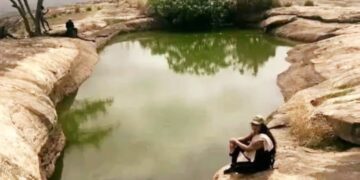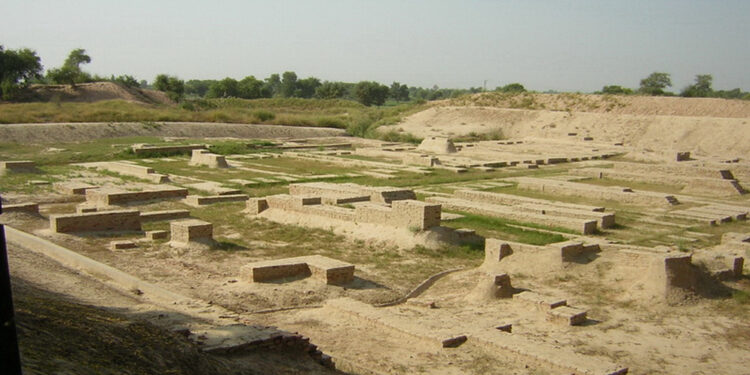So, the Harappan civilization now appears as quite dynamic, the appearance of which has changed over the centuries. For reconstruction of the processes occurring in it, paleo-economics, information theories, etc. are attracted. The assumptions built on them are certainly worthy of attention, although their correction as a result of new data is very likely.
Excavations at the site of Harappa.
Excavations at the site of Harappa.
At an early stage, a culture, the region of which is very wide, does not appear homogeneous – signs of the uniqueness of material culture make us think that they reflect features in the field of traditions, economic life, ethnos and language. They suggest that the circulation of information in the broad sense of the word was carried out at the level of family ties by representatives of individual communities. One can assume competition between different social groups with different statuses, while conditions were created for the development of high status groups. At the stage of developed Harappa, the picture is changing. Production, including agricultural production, is intensifying, and the role of crafts and, probably, exchange, is growing sharply. It has been suggested that up to 50% of the population was concentrated in cities. A variety of economic, cultural and ethnic areas,
Relations between regions are changing. In Balochistan, life was preserved in relatively few settlements, including those concentrated on strategically important routes to Iran and Afghanistan. At the same time, there is reason to talk about the increasing role of maritime trade and exchange or trade, which was carried out along the coast of Makran, as well as the southern coastal region. The creation of a direct trade system over long distances is caused by the desire to get rid of the “intermediaries”. The period of mature Harappa is the time of territorial expansion to the south and east, carried out, as far as the data permit, not by military force, but due to economic growth and the ability to maintain balanced social relations. At the same time, the existence of fortifications in large and small cities is significant (in the small Surkotad, throwing nuclei were found on the “citadel”).
In the period of the developed Harappa, an important role is played by relations not only of kinship (which can be assumed for the predominantly “rural civilization”), but also those determined by professional affiliation, status and / or rank, and not so much inherited as acquired, those. achieved as a result of human activities. Contacts are built both directly and through intermediaries, they become more impersonal. This is evidenced by the spread of writing.
Modern view of the ruins of Harappa.
Modern view of the ruins of Harappa.
The final period of the Harappan civilization and the post-Harappan situation. Its time is still not well defined, about the second quarter – the middle of the second millennium BC, the integrity of culture and its whole appearance undergo changes. Signs of this are manifested in the desolation of large centers, in the differences in the evolution of ceramic complexes of large settlements (Harappa and Mohenjo-Daro), and the addition of various local styles. The regularity of settlement planning is being lost, the construction technique is deteriorating, writing is disappearing, the standard system of measures and weights is going out of use. Nevertheless, in the field of agriculture, continuity persists, as in the traceable elements of life and religious beliefs. According to researchers, primarily Indian, they can persist until recently or modern times. Signs of late Harappan culture can be traced in Punjab, Gujarat, Uttar Pradesh. According to some sources, about 500 Late Harappan settlements existed in Haryana and the outskirts of Delhi, and some inhabitants grew rice. There is evidence that late Harappa archaeological complexes coexisted with the so-called painted gray ceramics (Painted Gray Ware, PGW), which will be discussed below.
Possible causes of extinction
As in the study of other early civilizations, researchers of the final period of Harappa’s existence and its end often proceeded from common principles common in the historical science of their time. So, the supposed disappearance of a vast civilization was depicted as a result of its destruction by aliens, in this case, the Aryans. As an indication of this, they considered the existence of a defensive wall on Harappa Hill and the skeletons of supposedly dead people in Mohenjo-Daro. At the same time, there were practically no signs of forced capture in the settlements.
New, meticulously collected data from the territory of the Harappan civilization itself and from neighboring regions allow us to outline the features of a more complex picture. Among the possible causes are natural disasters – severe flooding or, conversely, the desiccation of the Ghaggar system in Punjab, from where the population could move to the Ganges-Yamuna interfluve. Based on the assumption that there is no state apparatus in civilization, it is quite obvious that such an extensive education, whose existence depended not only on its own resources, but also on ties with more or less distant regions, was relatively fragile, and its unity could not belong . Researchers in recent decades have insisted on the unsuitability of simplified models (one of which is the invasion of alien masses) to comprehend what was happening in the first half of the 2nd millennium BC. changes in the north of the Indian subcontinent, in Central Asia and Iran.
When considering changes in the late Harappa, one cannot exclude the possibility of large-scale impacts, changes in the historical situation in the vast territories of Asia. As already mentioned, in the first half of II millennium BC. The directions of trade relations between Mesopotamia and neighboring countries are changing. With the emergence of the state of Hammurabi, trade relations are reoriented to the west. It is possible that these processes played a role in upsetting the traditional balance prevailing in the Indus Valley and in the adjacent areas of Central Asia.
In the second quarter of II millennium BC in Central and South Asia there are processes that, in archaeological terms, appear as a violation of the continuity of the development of cultures existing here. People leave their settlements, in which life continues to warm. Large cities are disappearing. There is a picture of the destruction of old ties and the formation of new ones. Previously sparsely populated areas are being developed. Signs of foreign cultural phenomena in different areas are becoming more frequent.
It is widely believed that the language of the speakers of the Harappan culture belonged to the Proto-Dravidian. The anticipated distribution belt of Dravidian languages in antiquity is Baluchistan, Sindh, Rajasthan, Malva and Maharashtra, as well as the Punjab and the Ganges Valley (note that the Dravidian-speaking population, according to some researchers, could inhabit both southern Iran and southern Turkmenistan). According to linguistic evidence, the Dravids came into contact with the Aryan aliens early, faced them, perhaps, before they reached the north of the subcontinent.
Parish of other ethnic groups
Around the middle of II millennium BC. the greatest complex of religious texts, the Rig Veda, created by these aliens, is taking shape. They were mobile pastoralists and farmers, significantly inferior to the “Harappans” in the development of material culture. Several generations of researchers have attempted to trace the path of the Indo-Aryans and Aryans from their alleged ancestral homeland to Central and South Asia and Iran, linking it, in particular, to the characteristic gray or stucco ceramics of the “steppe” look (common in the steppe belt of Eurasia and Kazakhstan) . These attempts, although yielding interesting results, have not yet been crowned with success because the events that took place in the region of interest to us in the 2nd millennium BC were extremely complex, and the processes were diverse and their details are either not reflected in archaeological sites, or rather
Taking into account the fact that the Arians, at least in part, were mobile pastoralists and that there are signs of their long-term “acquaintance” with the bearers of the Harappan civilization, it is legitimate to pay close attention to the communities that led such a way of life in those territories from which they could come arias. In this regard, the question arises of the ethnicity of at least partially mobile communities on the northwestern border of the Harappan civilization at the late stage of the developed and late Harappa, i.e. in the beginning – the middle of II millennium BC In Central Asia at the end of III and II millennium BC. there is an extremely vibrant archaeological culture, which has received the code name “Bactrian-Margian archaeological complex.” Her characteristic things are copper-bronze weapons, household items, cloisonne seals, objects of worship – found on a vast territory, far beyond the territory of the later Bactria and Margiana. They were also found in Balochistan, in Siberia near Mehrharh and in Quetta, where things characteristic of this culture made up part of the funerary inventory. At present, it is difficult to say whether these monuments are associated with the migration of population groups: whether they were left by seasonally nomadic herders or in the area of the Bolan Pass, an important point on the exchange routes, the inhabitants of Central Asia rushed in, trying to establish control over these routes. It seems that with even greater caution it can be assumed in carriers of complexes of this kind of Indo-ary. where things characteristic of this culture were part of the funerary inventory. At present, it is difficult to say whether these monuments are associated with the migration of population groups: whether they were left by seasonally nomadic pastoralists or in the area of the Bolan Pass, an important point on the exchange routes, the inhabitants of Central Asia rushed in, trying to establish control over these routes. It seems that with even greater caution it can be assumed in carriers of complexes of this kind of Indo-ary. where things characteristic of this culture were part of the funerary inventory. At present, it is difficult to say whether these monuments are associated with the migration of population groups: whether they were left by seasonally nomadic pastoralists or in the area of the Bolan Pass, an important point on the exchange routes, the inhabitants of Central Asia rushed in, trying to establish control over these routes. It seems that with even greater caution it can be assumed in carriers of complexes of this kind of Indo-ary.
Signs of contacts with remote northern regions, northern Afghanistan, northeastern Iran, southern Turkmenistan and Tajikistan are found in monuments of the 2nd millennium BC. Swat Valley. They are best studied in the burial grounds distributed from Inayat Kuil at the Pakistan-Afghanistan border in the west to the Indus in the east and from Chitral in the north to the river. Kabul in the south. Some similarities are found in burials, forms of ceramic vessels, metal products. These burial grounds and settlements belonged to farmers and pastoralists. Their homes were built of stone and clay, less often – raw brick. In the burial grounds, along with the remains of full skeletons, corpses were found in urns. At a later stage, a horse was known. The population belonged to several anthropological types – Mediterranean, protoavstraloid and Mongoloid. Such phenomena
Based on the data of the Rigveda, an assumption was made about the possible area of resettlement of the Aryans during the period of anthems in Northeastern Punjab. Here and in neighboring areas, they searched for evidence of their presence.
Attempts have been made to identify the carriers of several archaeological cultures of the north of the subcontinent with the Aryans. One of them is the jhu-car culture that existed in Sindh in the second half of the 2nd millennium BC. Its ceramics is somewhat different from the late Harappa, painting appears in black and red, peculiar stamps, characteristic bronze axes and pins. It is now believed that this culture is a local version of the late Harappa, marked by influence from Balochistan. Bb Lal in the 50s of the XX century. He suggested that the Aryans belonged to the so-called gray painted pottery culture discovered in the Punjab, Haryana, Northern Rajasthan and in the west of Utgar Pradesh, the basis for which was the territory of its distribution and estimated dating: end of II – beginning of I millennium BC. The bearers of this culture built houses from wickers, coated with clay, or from raw, bred buffalos, pigs, horses, sowed rice. In addition to the burial of the remains, cremation was also practiced, which corresponds to the notions of the burial rite of the Aryans. However, this attribution was soon called into question. It turned out that gray painted ceramics is not so characteristic of the selected complexes – it makes up only about 10% and is found in settlements of different times, including the Harappa type. The very occurrence of such ceramics is associated with specific firing, indicating the spread of iron technology. It was also noted that it does not occur on the alleged path of advancement of the Aryans, and the economy of its carriers is more likely to be eastern than western. horses, sowed rice. In addition to the burial of the remains, cremation was also practiced, which corresponds to the notions of the burial rite of the Aryans. However, this attribution was soon called into question. It turned out that gray painted ceramics is not so characteristic of the selected complexes – it makes up only about 10% and is found in settlements of different times, including the Harappa type. The very occurrence of such ceramics is associated with specific firing, indicating the spread of iron technology. It was also noted that it does not occur on the alleged path of advancement of the Aryans, and the economy of its carriers is more likely to be eastern than western. horses, sowed rice. In addition to the burial of the remains, cremation was also practiced, which corresponds to the notions of the burial rite of the Aryans. However, this attribution was soon called into question. It turned out that gray painted ceramics is not so characteristic of the selected complexes – it makes up only about 10% and is found in settlements of different times, including the Harappa type. The very occurrence of such ceramics is associated with specific firing, indicating the spread of iron technology. It was also noted that it does not occur on the alleged path of advancement of the Aryans, and the economy of its carriers is more of an eastern than a western origin. However, this attribution was soon called into question. It turned out that gray painted ceramics is not so characteristic of the selected complexes – it makes up only about 10% and is found in settlements of different times, including the Harappa type. The very occurrence of such ceramics is associated with specific firing, indicating the spread of the technology of using iron. It was also noted that it does not occur on the alleged path of advancement of the Aryans, and the economy of its carriers is more likely to be eastern than western. However, this attribution was soon called into question. It turned out that gray painted ceramics is not so characteristic of the selected complexes – it makes up only about 10% and is found in settlements of different times, including the Harappa type. The very occurrence of such ceramics is associated with specific firing, indicating the spread of the technology of using iron. It was also noted that it does not occur on the alleged path of advancement of the Aryans, and the economy of its carriers is more likely to be eastern than western. indicative of the spread of iron technology. It was also noted that it does not occur on the alleged path of advancement of the Aryans, and the economy of its carriers is more likely to be eastern than western. indicative of the spread of iron technology. It was also noted that it does not occur on the alleged path of advancement of the Aryans, and the economy of its carriers is more likely to be eastern than western.
It was assumed that the Aryans belonged to a culture of ocher ceramics, characterized by poor firing and a buffy surface. It is common in Hastinapur. Now they believe that this culture is local and belongs to the late Harappan time. Another culture of II millennium BC – a culture of copper treasures, the signs of which are found from West Bengal and Orissa to Gujarat and Haryana and from Utgar Pradesh to Andhra Pradesh. It is characterized by products made of almost pure copper – flat Celt axes, swords with antenna tops, harpoons, spearheads, anthropomorphic figures cast in single or double-sided forms. It is believed that the bearers of this culture were hunters and warriors, some tools were intended for clearing the jungle; they were not engaged in agriculture. The origin of this culture remains unclear, it is possible that it belonged to migrants from the territory of Harappa. It is believed that it belonged to the ancestors of the modern munda. The range of monuments is expanding, allowing us to think that at the end of II millennium BC. in the territory of Harappan civilization, in connection with the appearance of native speakers of a new language, a cultural vacuum did not arise. The penetration of the Aryans was not an instantaneous event, it took place as a whole gradually, probably, they borrowed many elements of the culture of the local population. Clashes between them and the local inhabitants obviously took place, but they did not necessarily occur in the early stages of penetration. In conclusion, we can agree with F.R. Allchin and other scholars in the fact that the “Indo-Arianization” of India was a dynamic process in the succession and cultural development, which lasted several centuries. that it belonged to the ancestors of the modern munda. The range of monuments is expanding, allowing us to think that at the end of II millennium BC. in the territory of Harappan civilization, in connection with the advent of native speakers of a new language, a cultural vacuum did not arise. The penetration of the Aryans was not an instantaneous event, it took place as a whole gradually, probably, they borrowed many elements of the culture of the local population. Clashes between them and the local inhabitants obviously took place, but they did not necessarily occur in the early stages of penetration. In conclusion, we can agree with F.R. Allchin and other scholars in the fact that the “Indo-Arianization” of India was a dynamic process in the succession and cultural development, which lasted several centuries. that it belonged to the ancestors of the modern munda. The range of monuments is expanding, allowing us to think that at the end of II millennium BC. in the territory of Harappan civilization, in connection with the appearance of native speakers of a new language, a cultural vacuum did not arise. The penetration of the Aryans was not an instantaneous event, it took place as a whole gradually, probably, they borrowed many elements of the culture of the local population. Clashes between them and the local inhabitants obviously took place, but they did not necessarily occur in the early stages of penetration. In conclusion, we can agree with F.R. Allchin and other scholars in the fact that the “Indo-Arianization” of India was a dynamic process in the succession and cultural development, which lasted several centuries. that at the end of II millennium BC in the territory of Harappan civilization, in connection with the advent of native speakers of a new language, a cultural vacuum did not arise. The penetration of the Aryans was not an instantaneous event, it took place as a whole gradually, probably, they borrowed many elements of the culture of the local population. Clashes between them and the local inhabitants obviously took place, but they did not necessarily occur in the early stages of penetration. In conclusion, we can agree with F.R. Allchin and other scholars in the fact that the “Indo-Arianization” of India was a dynamic process in the succession and cultural development, which lasted several centuries. that at the end of II millennium BC in the territory of Harappan civilization, in connection with the advent of native speakers of a new language, a cultural vacuum did not arise. The penetration of the Aryans was not an instantaneous event, it took place as a whole gradually, probably, they borrowed many elements of the culture of the local population. Clashes between them and the local inhabitants obviously took place, but they did not necessarily occur in the early stages of penetration. In conclusion, we can agree with F.R. Allchin and other scholars in the fact that the “Indo-Arianization” of India was a dynamic process in the succession and cultural development, which lasted several centuries. they probably borrowed many elements of the culture of the local population. Clashes between them and the local inhabitants obviously took place, but they did not necessarily occur in the early stages of penetration. In conclusion, we can agree with F.R. Allchin and other scholars in the fact that the “Indo-Arianization” of India was a dynamic process in the succession and cultural development, which lasted several centuries. they probably borrowed many elements of the culture of the local population. Clashes between them and the local inhabitants obviously took place, but they did not necessarily occur in the early stages of penetration. In conclusion, we can agree with F.R. Allchin and other scholars in the fact that the “Indo-Arianization” of India was a dynamic process in the successive-cultural development, which lasted several centuries.












